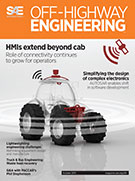Magazine

Tech Briefs: October 2018
2018-10-01
Detecting Drones with Doppler-Based Radar Digital Transformation for a Connected Enterprise Using Electromagnetic Brakes to Keep Thrust Reversers in Place Thermostatic Solutions for Temperature Control Applications Bringing RF into the Embedded World: It's Time Compact Power Amplifier Solution for Electronic Warfare Burner Rig Testing of A500® C/SiC Test method simulates, in a laboratory environment, the service conditions ceramic-matrix composite material would experience in turbine engine exhaust applications. Space Debris Orbit and Attitude Prediction for Enhanced and Efficient Space Situational Awareness Developing accurate models to predict the behavior of manmade debris in space could be the key to preventing collisions with satellites. Maintaining Enterprise Resiliency Via Kaleidoscopic Adaption and Transformation of Software Services (MEERKATS) Implementing new technologies to create a more resilient, secure cloud computing environment.



















